
August 15, 1969; “Woodstock Music and Art Fair” gets under way in Bethel, New York. Max Yasgur’s dairy farm had been chosen as the site only weeks before the event was scheduled to begin as neighbouring areas had refused to issue the needed permits to the promoters. Organizers, however, had repeatedly assured the various townships that the event would only draw 50,000 people. However, the promoters had issued 186,000 advance tickets at $18. They anticipated 200,000 would show up; tickets at the gate would be $24.
As for the entertainment, the line-up of bands performing grew more and more impressive after Creedence Clearwater Revival became the first to be signed.

With the dairy farm chosen as the site at the eleventh hour, though, Woodstock’s organizers are unprepared and face a difficult choice; finish the fencing and the ticket booths or build a stage. What would a three-day concert featuring 32 acts be without a stage? But without barriers and ticket booths, the promoters can no longer expect to make money from their venture. With people arriving in the tens of thousands on the Wednesday before the event, organizers declare it a free concert.
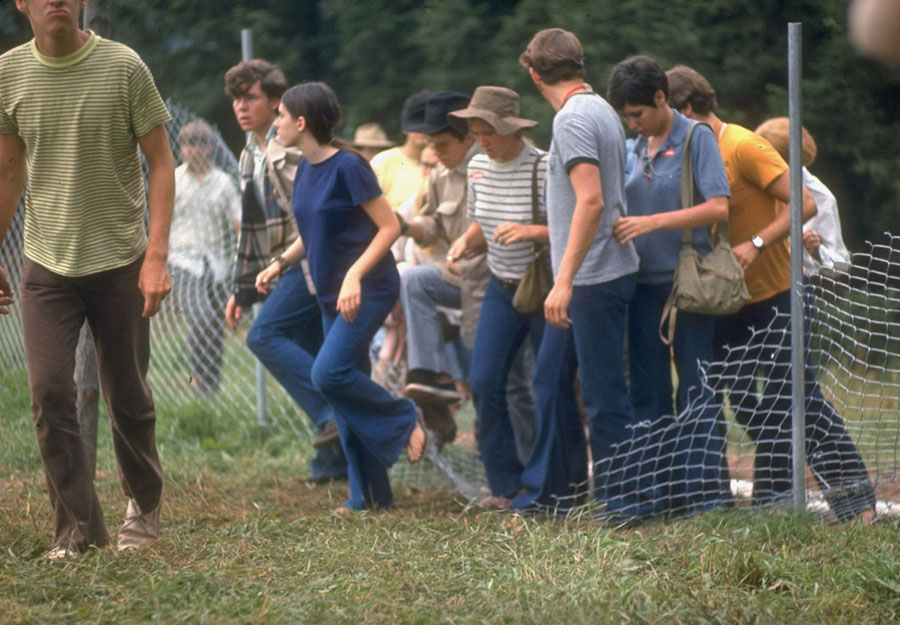
Notable performances from Day 1: Richie Havens opens the event at 5:07 pm after scheduled openers Sweetwater are detained by police on their way to the site; the band would go on later the same day. Bert Sommer is one of the lesser-known acts to appear but receives the first standing ovation of the concert for his rendition of Simon and Garfunkel’s “America”. Melanie goes on at 10:50 pm when the Incredible String Band refuses to play in the rain. A six-months pregnant Joan Baez finishes the first day.
August 16, 1969; The amount of people attending the concert results in massive traffic jams. Radio stations as far away as Manhattan are reporting on the congestion. At the site, attendees are dealing with the results of rainstorms; Yasgur’s farm is a mud bog. The county declares a state of emergency and the local Air Force base helps out with security and airlifting performers to and from the airport.
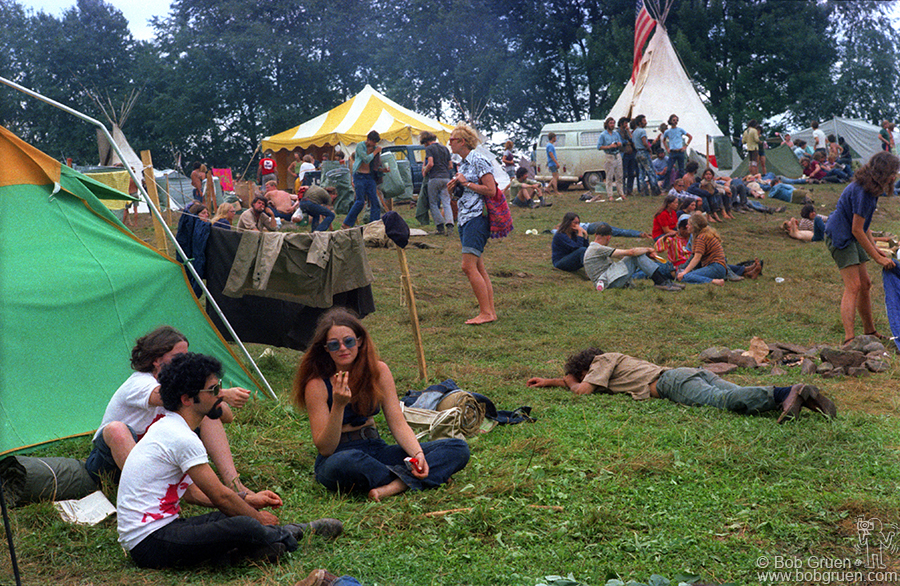
At the site itself, all is groovy. Attendees commune with nature, playing in the mud and swimming and bathing in the nearby pond. And the sounds emanating from the stage are nothing less than historic.
It is on this day that the crowds are treated to two performances of epic proportions. At 2 pm, Santana hits the stage with their kid drummer, Michael Shrieve. At 20 years old, Shrieve is the youngest musician performing at the festival. When his band launches into “Soul Sacrifice”, lives are never the same. Shrieve’s solo is later described as “electrifying” and his boss, Carlos Santana, lays down some guitar work the likes of which has seldom been heard before. Or since. And Santana’s face as he plays is all-world.
In the middle of the night – 3:30 am – one of the event’s few black acts, Sly and the Family Stone, takes the stage. Sly’s rendition of “I Want to Take You Higher” is a visual and aural feast. Stone has literally tens of thousands of people singing in unison, the hills virtually surging. A year later, the documentary film will cement the moment in history. Sly’s fringes flying through the air in slow motion is one of the indelible images of the event. Of the era.
Other highlights from Day Two: power trio Mountain take the stage at 9 pm for only their third gig together. They are followed by the Grateful Dead; their set is cut short when they burn out the amps with “Turn On Your Love Light”. Creedence Clearwater Revival are miffed about going on after midnight. They (John Fogerty) will subsequently refuse to be represented in the film or on the soundtrack album. The second night wraps with The Who and Jefferson Airplane. Consider; in the same place, on the same stage on the same day you have Santana, Canned Heat, Mountain, the Grateful Dead, CCR, Janis Joplin, Sly and the Family Stone, the Who and Jefferson Airplane. And most people saw them for free.
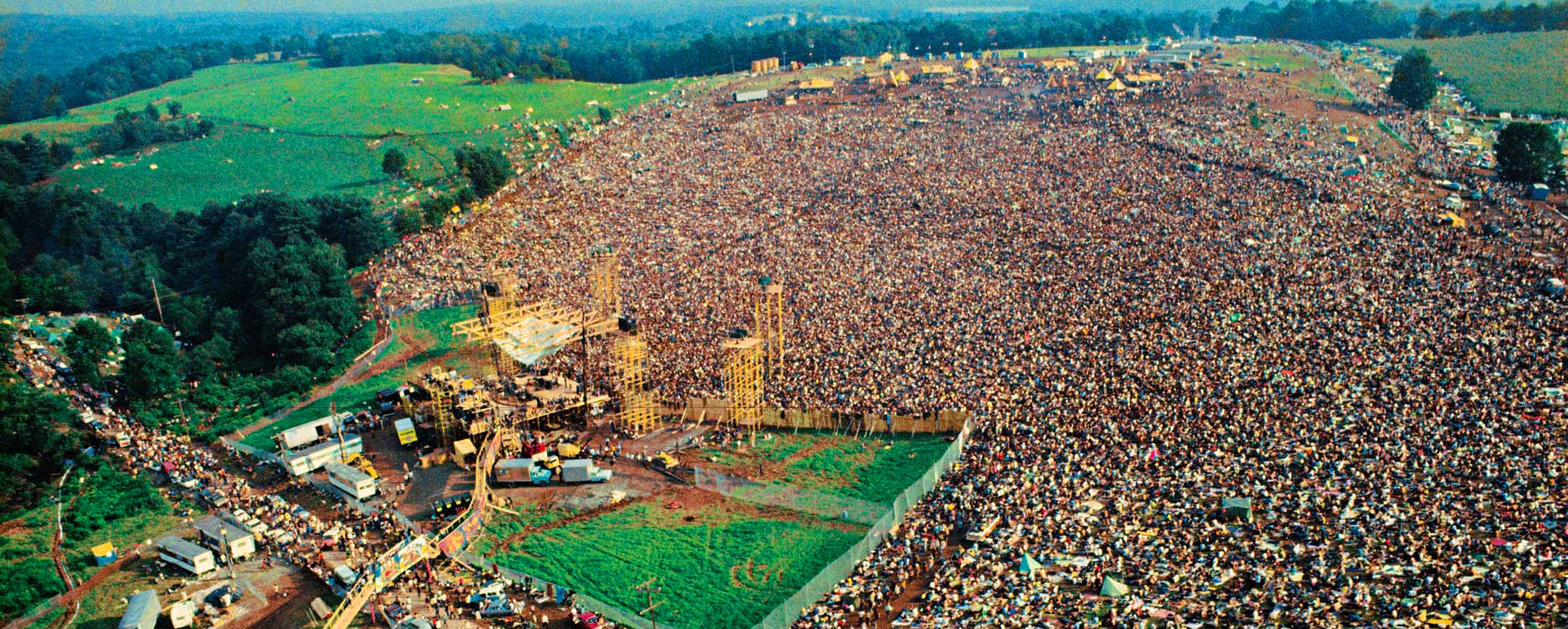
August 17, 1969; Woodstock has “broken even”. Two births are reported; one in a car caught in traffic and one after an airlift to hospital. And two deaths occur; one from insulin usage and one occurred when a tractor accidentally ran over someone in a sleeping bag. One reporter later said he was “encouraged” by his editor to fabricate negative coverage of the event but society is forced to accept that this many kids got together in one place and did indeed live peacefully. The final tally runs to roughly 400,000 people; BY FAR the largest “city” in New York apart from NYC. By TODAY’S numbers, they’d be the 48th largest city in the entire country. Larger than Tampa, New Orleans and Cleveland.
On Day Three, Joe Cocker tears people’s heads off with his set and then thunderstorms shut things down for three hours. Now, the event is way behind schedule. Sunday evening sees a smoking set by Ten Years After and performances by Crosby, Stills, Nash and Young and two Canadian acts; The Band and Blood, Sweat and Tears. And still surprising to me is the appearance of the penultimate act, Sha Na Na. It is actually Monday morning at 9 am when closer Jimi Hendrix takes the stage. Although he is playing to a decimated crowd, the images and sound captured of Hendrix playing “The Star-Spangled Banner” are nothing less than iconic and representative of a generation.
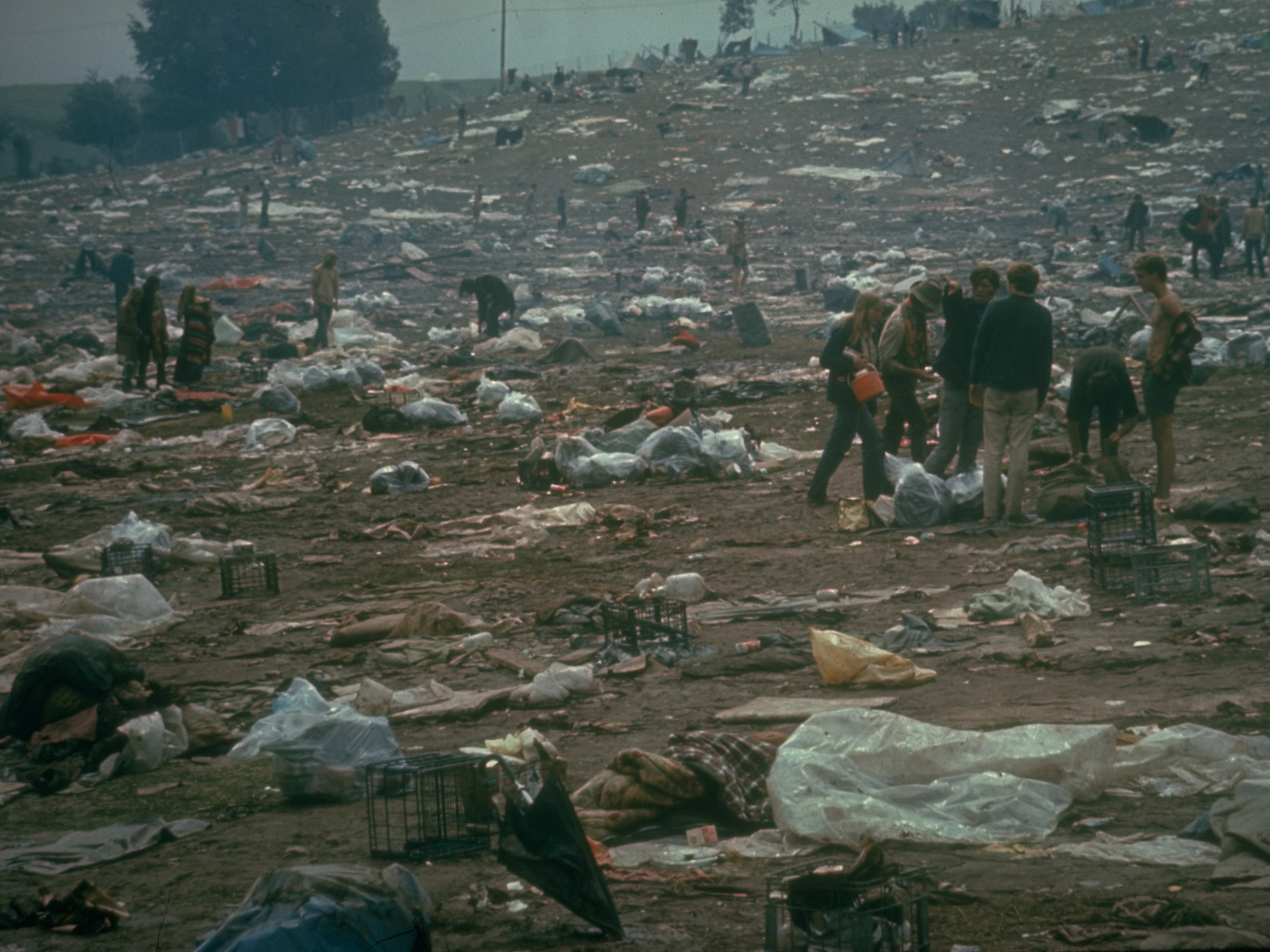
In the aftermath of Woodstock, New York State and Bethel passed laws prohibiting the gathering of this many people. In the ensuing years, owners of the land tried to prevent people from trespassing on the site to mark anniversaries but in the last twenty years, plaques and markers and visitor centers have sprung up as the locals have finally embraced their place in history.
Many legendary bands declined their invitations for various reasons. Most thought it would be just another festival, some had better paying gigs elsewhere. Most, I assume, wished they had been there; Simon and Garfunkel, the Byrds, the Moody Blues, the Doors and Jethro Tull. Led Zeppelin’s manager declined because they would have been just another band on the bill. Tommy James says his secretary called him in Hawaii and said “there’s a pig farmer in upstate New York that wants you to play in his field” so he naturally declined. Canadian Joni Mitchell’s manager urged her to decline her invite so she wouldn’t miss an appearance on The Dick Cavett Show. While watching news footage of the event, she would write the hit song, “Woodstock”. Roy Rogers was asked to close the event with “Happy Trails” but he declined. The Beatles were asked to appear but they were disintegrating at the time and declined.
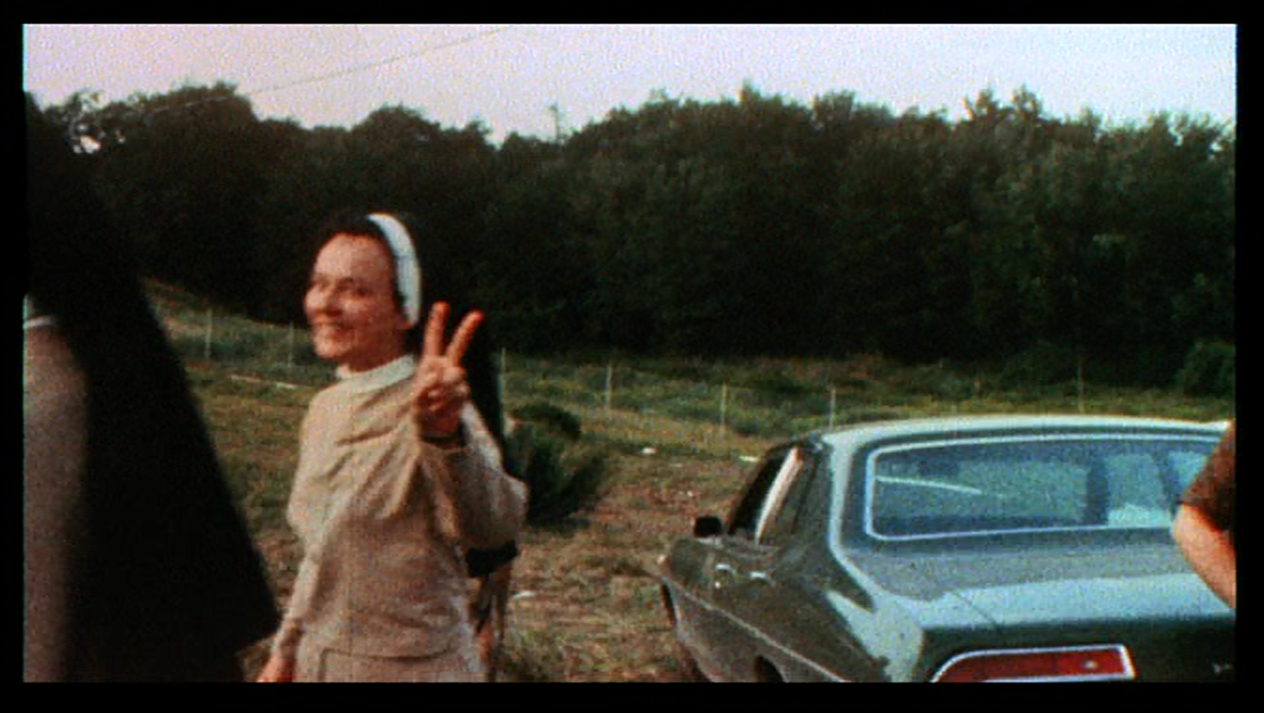
What really continues to captivate me about Woodstock is imagining the personal stories that must have played out before, during and after the event. Surely the people who attended did not immediately realize the historic significance of the concert but I can’t help thinking about the varied individual experiences that must have taken place. There surely is a screenplay – multiple screenplays – that could be written here. Consider the two babies born at Woodstock. Let that sink in – born at Woodstock. Only two people in history can sit around talking about their parents – were they married? Even a couple? – bringing them into the world amidst such chaos, yes, but also into a communal spirit filled with peace, love and music. The poor individual who died in his sleeping bag. For his family, every mention of this iconic event brings sadness and pain.
Look at the kids who were interviewed in the documentary, the stories they relate. We weren’t a couple but we went to Woodstock together. It was an amazing experience but when we got back home we went on with our lives. I got married and had kids but I never forgot him. We keep in touch. Mom, you’re so close with this guy. Isn’t Dad mad? I mean, who is he? Is he an old boyfriend? No, but we were at Woodstock together. Groups who went to the concert together getting separated, asking for friends to be paged. We’re supposed to go home together, we gotta get ready for school in the fall or back for work Monday, I don’t know where they are. Plane tickets; if you miss your flight… I hitch hiked home from Woodstock. A nice, old couple drove me home. Or I got a ride with a group of kids and we made lifelong connections. When I got home and let it all sink in I realized I would never be the same. Back on campus or on the street corner. What did I do this summer? I went to Woodstock. It blew my mind. I saw hundreds of thousands of people just like me living in peace and harmony. It was the utopia we’ve been looking for. It kills me that it can’t be like that all the time.
The lineups for the payphones to call home. The bridges that may have been built to span the generation gap. When I got home, my folks said they had been watching the coverage on TV. Even though they had been against my going, the whole event seemed to make them look at me differently. As if a little light had been turned on. Things were much better between us that fall. Or I went to Woodstock against my parent’s wishes. They never spoke to me again. When I got home, I packed a bag and split. And what about the couple pictured on the cover of the soundtrack album who are still together today? Like other major cultural events with a sociological impact, it’s often people’s personal interaction with such events that help put it in perspective and provide the most insight and reflection for us viewers and students from later generations.
Woodstock holds a special place in history. Maybe half a million people were positively affected by it. The stories, the feelings, the memories, are legion.
Great read as always. The John Fogerty CCR appearance is fascinating. Funnily enough, Mr Fogerty is now proudly trumpeting that he was, in fact, at Woodstock, as he is now on a very successful 50th anniversary tour to big crowds and critical acclaim. Unfortunately the other poor lads; Stu Cook, Doug Clifford, and John’s late brother Tom Fogerty, are not rating a mention. At least in the official John Fogerty publicity on social media that I’ve seen thus far. I’m a fan of John Fogerty so I mean no disrespect – saw him live 20 or so years ago – and he seems to be a very nice guy. I understand he remains angry at his surviving bandmates over royalty disputes with Fantasy Records and Saul Zaentz. But surely this late in the day, a little grace – and the recognition that Creedence was three other guys as well – wouldn’t do any harm. I was also interested to read your comments about the quality of the performances. I wonder just how good the sound really was, to the people actually there?
So many beefs over the years with so many acts. Too bad – CCR’s music was so “down home”, you’d like to think the guys were the same. Maybe John is a great guy but 50 years down the line you could throw some love to the others. But I gotta say: if there was ever a band that was ONE GUY it was CCR.
You often hear jokes about not being able to hear the music if you were far away but I can’t see that. It’s not as if they were playing in some barn with bad acoustics. If anything, I would think the music carried for miles. On the soundtrack and movie it sounds fine but you can’t go by that. If you read up on the sound set up it sounds impressive.
Thanks for reading!